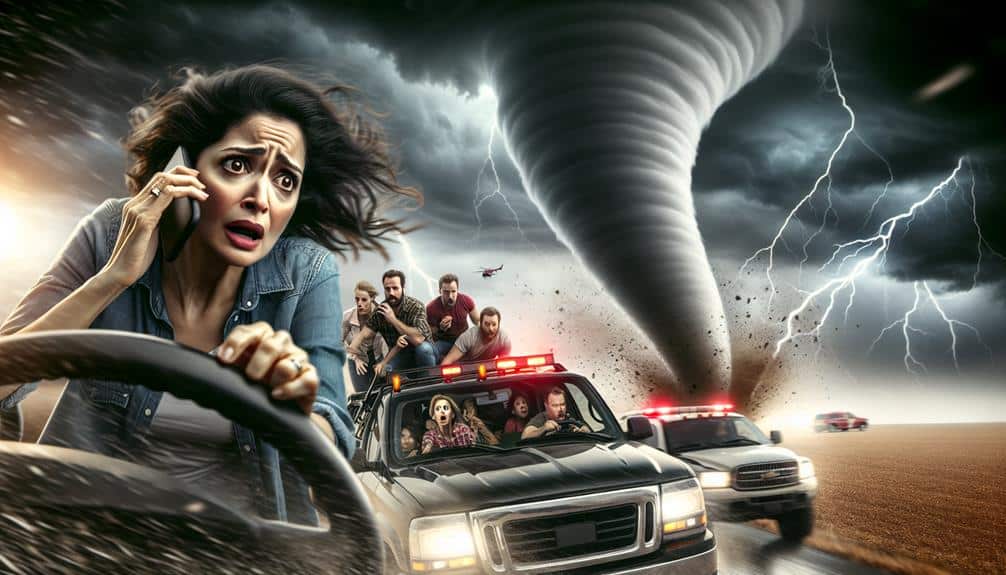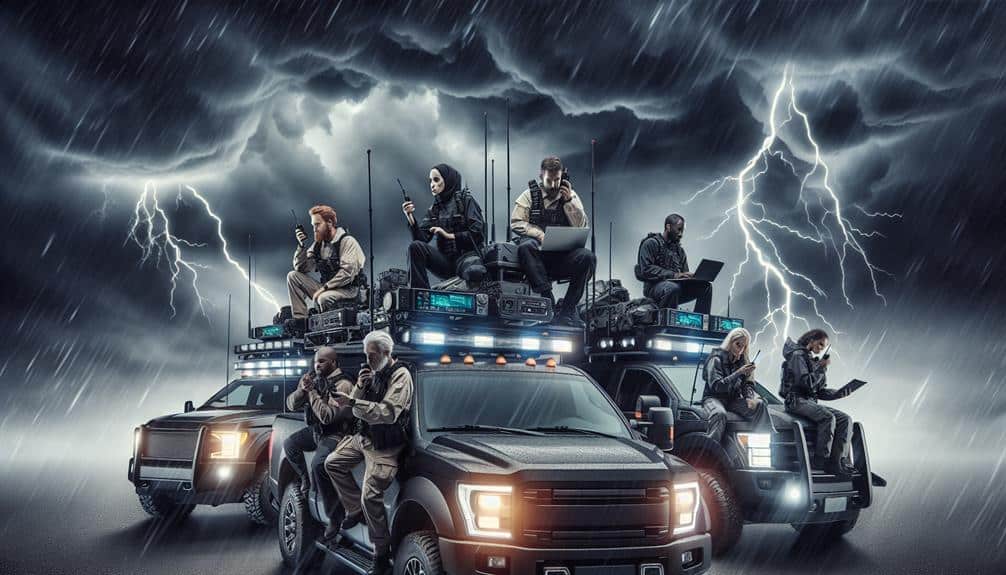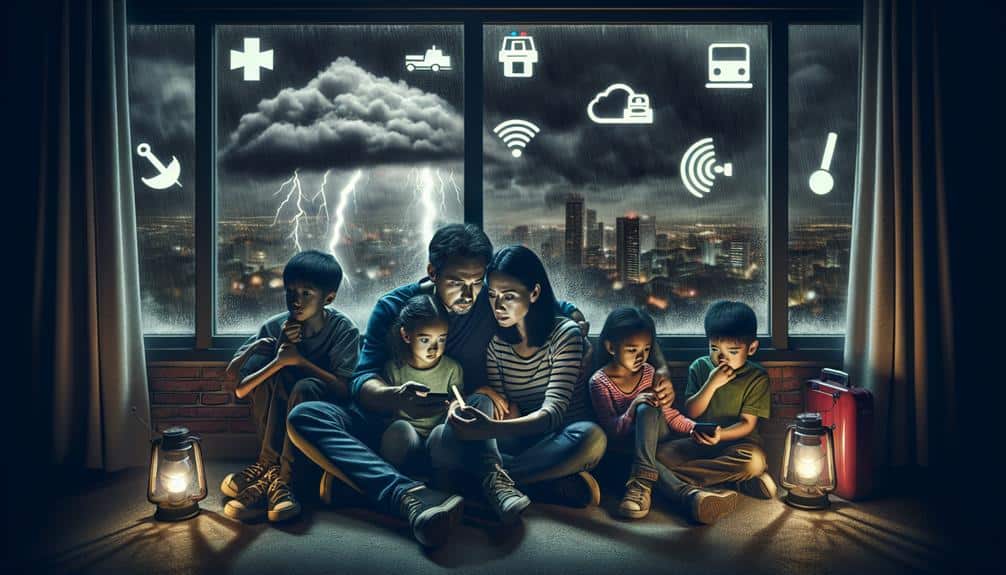We guarantee public safety during severe weather by establishing reliable communication channels, utilizing real-time data, and prioritizing clear messaging. Our strategies include deploying text alerts, social media updates, and automated calls, supported by real-time data analysis and predictive models. We coordinate closely with local authorities and conduct regular drills to identify gaps. By tailoring messages to specific audiences and leveraging technology tools like remote monitoring systems and IoT devices, we provide accurate, timely information that empowers decision-making. With this framework, we can respond swiftly and effectively, ensuring that everyone stays informed and safe during critical times. Explore further to learn how each strategy works in detail.
Key Points
- Utilize multiple communication platforms like text alerts, emails, and social media for broad-reaching, timely updates.
- Disseminate real-time data using advanced analysis techniques and predictive models for accurate weather forecasting.
- Ensure clear, consistent messaging with standardized terminology and visual aids like maps and infographics.
- Establish real-time communication channels with local authorities to streamline information flow and response efforts.
Establishing Reliable Channels
Establishing reliable communication channels is essential to guarantee timely and accurate dissemination of information during severe weather events. We must make sure that emergency notifications reach every member of our community without delay. This means utilizing a variety of platforms to cater to different preferences and accessibilities. From text alerts and emails to social media updates and automated phone calls, each medium plays a vital role in our thorough strategy.
For effective community outreach, we need to build a network that includes local media, schools, businesses, and civic organizations. These partners can amplify our messages, ensuring they reach every layer of our community. By conducting regular drills and simulations, we can test the strength of these channels and identify any gaps in our communication strategy.
Furthermore, we should establish a feedback loop to refine our processes. Gathering input from the community allows us to understand their needs better and tailor our approaches accordingly. It's crucial to provide clear, concise, and actionable information to empower individuals to make informed decisions.
Utilizing Real-Time Data
Harnessing real-time data allows us to make swift, informed decisions during severe weather events. By integrating advanced data analysis techniques, we can quickly interpret incoming information to predict weather patterns, assess risks, and implement safety measures. This capability is vital for maintaining public safety and ensuring that resources are allocated efficiently.
We utilize various communication platforms to disseminate this real-time data to the public and relevant authorities. These platforms include social media, emergency alert systems, and dedicated weather applications. Each platform serves a unique purpose, offering tailored information streams based on the needs of different user groups. For instance, social media provides rapid updates and wide reach, while specialized apps offer detailed, customizable alerts.
Our approach to data analysis involves harnessing machine learning algorithms and predictive models to enhance the accuracy of weather forecasts. This enables us to anticipate severe weather conditions with greater precision, allowing communities to prepare proactively. As we receive new data, our systems automatically update, ensuring that the information we communicate is current and reliable.
Prioritizing Clear Messaging
Clear messaging ensures that important information about severe weather events is quickly and accurately conveyed to the public. Our primary objective is to guarantee that everyone understands the seriousness of the situation without any doubt.
To achieve this, we must tailor information to specific audiences, recognizing that different groups may require different details. For instance, residents in coastal areas need updates on storm surges, while those inland focus on wind damage and flooding.
We also need to address the significance of minimizing confusion. Conflicting reports and unclear directives can lead to dangerous delays in response times. By using standardized terminology and clear, concise instructions, we can greatly reduce the likelihood of misinterpretation. Consistency across all communication channels—whether it's social media, traditional news, or emergency alerts—is important.
Moreover, visual aids such as maps and infographics can enhance understanding. These tools translate complex data into easily digestible formats, making it easier for the public to grasp the situation at hand.
Coordinating With Local Authorities
When coordinating with local authorities, it's essential to establish real-time communication channels to make certain timely dissemination of updates and directives. We must prioritize creating a network where information flows smoothly between emergency management teams and local government entities. This guarantees that everyone is on the same page, reducing the likelihood of miscommunication during critical moments.
Collaborating with communities is a key element of our strategy. By involving local leaders and organizations in our planning and response efforts, we can foster a sense of ownership and active participation. This collaboration not only builds trust but also leverages local knowledge that can be vital during an emergency.
Emergency response coordination requires us to have pre-established protocols. We should conduct regular drills and simulations with local authorities to identify potential gaps and improve our response capabilities. These exercises help us fine-tune our strategies and make certain that everyone knows their roles and responsibilities.
Leveraging Technology Tools

One of the most effective ways we can enhance our communication during severe weather events is by utilizing advanced technology tools. These tools enable us to monitor conditions in real-time and disseminate crucial information swiftly. Remote monitoring systems, for instance, allow us to track weather patterns and potential hazards with precision. By leveraging data from satellites, weather stations, and IoT devices, we can make informed decisions and provide timely updates to the public.
Social media platforms also play an essential role in our communication strategy. They allow us to reach a broad audience quickly and efficiently. By posting alerts, safety tips, and real-time updates on platforms like Twitter, Facebook, and Instagram, we guarantee that essential information is accessible to everyone. Additionally, social media enables two-way communication, allowing us to receive feedback and respond to questions and concerns from the community.
Integrating these technology tools into our communication framework not only improves the speed and accuracy of our responses but also empowers individuals with the information they need to make safe decisions. By staying connected and informed, we can better navigate the challenges posed by severe weather events.
Frequently Asked Questions
How Can I Prepare My Family for a Severe Weather Event?
We can prepare our family by developing clear emergency plans and guaranteeing robust family communication. We'll designate safe areas, assemble emergency kits, and practice drills regularly to guarantee everyone understands their roles and actions during a severe weather event.
What Are Some Common Myths About Severe Weather That Should Be Debunked?
We've all heard crazy weather misconceptions! It's time these myths get debunked. Tornadoes can't cross rivers, and opening windows equalizes pressure? Wrong! Severe weather facts are often misunderstood. Let's free ourselves from these dangerous beliefs.
How Do I Create an Emergency Kit for Severe Weather Situations?
When creating an emergency kit for severe weather, we should include essential emergency supplies like water, non-perishable food, and first aid items. Don't forget to include a detailed evacuation plan to guarantee our safety and freedom.
What Role Do Community Shelters Play During Severe Weather Events?
Community shelters play a significant role during severe weather events. They provide essential shelter assistance and foster remarkable community support. We depend on them to guarantee safety and unity, giving everyone the freedom to weather the storm together.
How Can I Help My Neighbors Who Might Need Assistance During Severe Weather?
To offer neighborly assistance, we can establish support networks by exchanging contact information, creating a communication plan, and organizing resources like food, water, and first aid supplies to guarantee everyone's safety during severe weather events.


